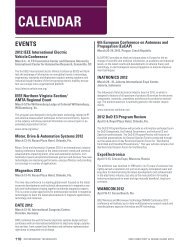2011 EMC Directory & Design Guide - Interference Technology
2011 EMC Directory & Design Guide - Interference Technology
2011 EMC Directory & Design Guide - Interference Technology
Create successful ePaper yourself
Turn your PDF publications into a flip-book with our unique Google optimized e-Paper software.
testing & test equipment<br />
Hi g h P o w e r El e c t r o m a g n e t i c Thr e at s t o t h e Smart Grid<br />
levels on the order of several hundred kV are possible that<br />
could seriously damage solid-state Smart Meters. As for<br />
distribution sensors and electronic controls, these would<br />
also be fully exposed to the E1 HEMP environment; without<br />
protection for the sensors, cables, electronics and communications,<br />
damage could be expected.<br />
Another concern is the protection of the control center<br />
for each power company that consists of computers/terminals<br />
and displays to keep track of the status of the power<br />
system under control and the supporting computer and<br />
communications rooms to send and receive data to and from<br />
substations. Currently there is some variation in the building<br />
construction quality used at different power companies<br />
(Table 1), but the best approach to avoid problems is to place<br />
the control center in the middle of the building on a low<br />
floor or in the basement. This is because soil and concrete<br />
provide some protection from high frequency EM fields.<br />
Locating the control center on the top floor with outside<br />
walls and windows increases the penetration of EM fields<br />
inside the building where they can interact directly with the<br />
computers and their ubiquitous Ethernet cables (which are<br />
extremely vulnerable to high levels of pulsed EM fields). In<br />
the context of Smart Grid, it is likely that more electronics<br />
and communications will be added to the control centers,<br />
increasing the likelihood of damage or upset to equipment<br />
that are required to operate at a higher data rate than today’s<br />
equipment.<br />
In terms of power generation, E1 HEMP is a threat to<br />
the low voltage controls of power plants, including those<br />
SCADA systems that control the flow of fuel to the generator.<br />
If additional communications are added to the<br />
generators to update the power control center periodically<br />
for Smart Grid, then these communication antennas, cables<br />
and electronics should be protected at least against damage<br />
(upset can be handled more easily as personnel are present).<br />
For the issue of distributed generation, the proliferation<br />
of variable generators such as wind turbines will require<br />
new communications for Smart Grid applications to keep<br />
track of the amount of power being generated on a shorter<br />
time basis. Both wind and solar power generators will be<br />
exposed to E1 HEMP fields, and additional test data are<br />
needed to determine whether the turbine electronics and<br />
power converters themselves will be able to survive the effects<br />
induced by E1 HEMP.<br />
Intentional electromagnetic interference<br />
(IEMI) impacts<br />
As indicated in Figure 2, IEMI environments tend to be<br />
present at somewhat higher frequencies than the E1 HEMP.<br />
The typical field levels are also on the order of 10s of kV/m<br />
(depending on the location of the attacker relative to the<br />
sensitive electronics), but because of the higher frequency<br />
content, most electronics appear to be slightly more vulnerable<br />
than when exposed to E1 HEMP. This is due to the fact<br />
that the penetration of EM fields into an equipment case is<br />
typically more efficient as the frequency increases. Also the<br />
ability to upset electronics is increased when the frequencies<br />
of the EM environment are similar to the operational<br />
frequency of a microprocessor (typically in the GHz range).<br />
E1 HEMP has most of its field energy below 100 MHz.<br />
While the IEMI threat field level is similar to E1 HEMP,<br />
it does not resemble a plane wave field that is propagating<br />
downward from space. Since the attacker for IEMI is likely<br />
within 100 meters, the EM field propagating away from the<br />
weapon tends to decrease as 1/r. This variation in field level<br />
with distance (unlike E1 HEMP) does not allow significant<br />
coupling to lines with length on the order of 100 meters or<br />
more. Therefore, IEMI is not a significant threat to insulators<br />
on medium voltage power lines. On the other hand,<br />
the IEMI threat to Smart Meters, distribution electronics,<br />
substation electronics, substation communications, control<br />
rooms and power generating facilities (including wind and<br />
solar facilities) is the same as for the E1 HEMP. Of course<br />
only one facility at a time is exposed by IEMI, but a team of<br />
criminals or terrorists could expose a significant set of assets<br />
in a city or town by using a weapon mounted inside a vehicle.<br />
Late-time (E3) HEMP impacts<br />
The late-time (E3) HEMP produces a disturbed geomagnetic<br />
field beneath the burst that induces slow rising (rise time<br />
on the order of 1 second) electric fields in the Earth up to<br />
40 V/km. The area coverage beneath the nuclear burst is on<br />
the order of several thousand kilometers and long trans-<br />
52 interference technology emc <strong>Directory</strong> & design guide <strong>2011</strong>




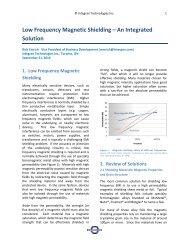

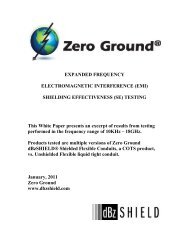
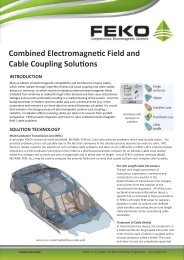



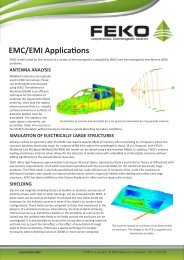
![[ thursday ] morning sessions 8:30 am-noon - Interference Technology](https://img.yumpu.com/23176841/1/190x247/-thursday-morning-sessions-830-am-noon-interference-technology.jpg?quality=85)
